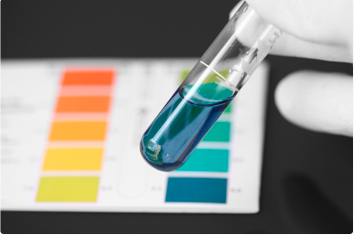Test the water yourself
Water is cool, clear, colorless and odorless. It must not contain any foreign substances in concentrations that are hazardous to health and must not make you sick even with lifelong consumption. So much for the legal requirements of our drinking water. However, many consumers are not aware that they are basically responsible for the water quality themselves. The respective water suppliers must of course provide drinking water of the right quality, but cannot guarantee how it will come out of the tap at home. The last few meters, i.e. the water pipes in the house, are decisive.
You don’t see the danger. Heavy metals lurk in pipes that can be released. Lead, copper and nickel are serious hazards. Particular care should be taken with pregnant women, babies and small children. Bacteria can also breed in pipes and get into the water in increased numbers. Particular caution is required with domestic wells. Many well owners do not know the exact composition of the water. In many cases, however, the quality is hardly sufficient.
This is what water tests offer you to test yourself
If you are not sure whether the water quality is right, you may be looking for a water test online. Many offer the opportunity to test water yourself. That sounds tempting – you get a result quickly and you can usually get out of it cheaper than a laboratory test.
Various parameters can be tested with it. Basically, sets for testing the water itself usually cover water hardness, pH, lead, nitrate, nitrite and pesticides. Bacteria tests are also available, but these only show whether bacteria are present and not in what number. If you don’t want a set, you will also find tests for individual parameters.
Most tests work with test strips that just have to be dipped into the water. The result can be read off after a short waiting period. Other tests use the chemical principle of titration. That might sound complicated, but all you need is a steady hand. These are drip tests, you just have to slowly drop a solution into your water with a pipette. The water changes color. The number of drops required before discoloration can then be easily transferred to the concentration of the tested substance. This method is very popular in tests for water hardness.
Care should be taken when choosing a self-test. Many tests are designed for aquariums – the gradations and measured values on the test strips are of course intended for fish. You should take a close look at the respective test to see how useful this is.
Advantages and disadvantages of self-tests
The best argument for a self-test is probably the cost. Test sets can sometimes be found on the Internet for as little as 5 euros. A professional laboratory test is of course a lot more expensive, but its quality is also in a completely different league. Nevertheless, a self-performed water test can provide good clues for possible problems. You can then get to the bottom of the result with a laboratory test.
The major disadvantage of self-tests is their accuracy. This is very controversial, especially because many mistakes can happen. If, for example, the vessel is slightly soiled, this can seriously falsify the results. A laboratory can test this much more precisely with the appropriate equipment. The interpretation of the results is not always easy either. Consumers report, for example, that the gradations of the color ranges cannot be clearly distinguished. It is then difficult to correctly evaluate the result of test strips.
Conclusion: Either cheap or reliable
Checking the water quality is particularly important when there are children in the household or when they are supplied by a domestic well. A self-test is more of a rough estimate – so don’t be disappointed if it doesn’t work out well. But if you want to be on the safe side, spend a little more money and have your water tested in the laboratory.



